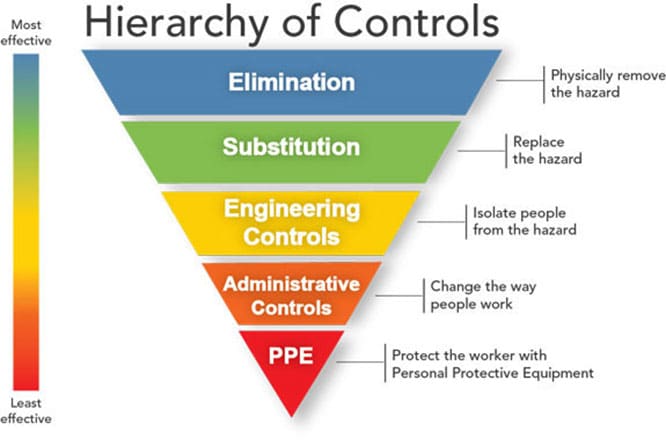Strategies for Optimizing the Supply of N95 Respirators---from CDC

Strategies for Optimizing the Supply of N95 Respirators---from CDC 0
Updated February 29, 2020
- Clarification of introductory language
- Information added on Crisis/Alternative Strategies
- Information added to expand upon strategies, including two new resources:
Audience: These considerations are intended for use by federal, state, and local public health officials, respiratory protection program managers, occupational health service leaders, infection prevention and control program leaders, and other leaders in healthcare settings who are responsible for developing and implementing policies and procedures for preventing pathogen transmission in healthcare settings.
Purpose: This document offers a series of strategies or options to optimize supplies of disposable N95 filtering facepiece respirators (commonly called “N95 respirators”) in healthcare settings when there is limited supply. It does not address other aspects of pandemic planning; for those, healthcare settings can refer to existing influenza preparedness plans to address other aspects of preparing to respond to novel coronavirus disease 2019 (COVID-19). The strategies are also listed in order of priority and preference in the Checklist for Healthcare Facilities: Strategies for Optimizing the Supply of N95 Respirators during the COVID-19 Response in an easy-to-use format for healthcare facilities.
The following strategies are based upon these assumptions: 1) facilities understand their current N95 respirator inventory and supply chain, 2) facilities understand their N95 respirators utilization rate, and 3) facilities are in communication with state and local public health partners (e.g., public health emergency preparedness and response staff) and healthcare coalitions. While these strategies are targeted for optimizing the supply of N95 respirators, some of these strategies may be applicable to optimizing the supply of other personal protective equipment such as gowns, gloves, and eye protection.

Controlling exposures to occupational hazards is a fundamental way to protect personnel. Conventionally, a hierarchy has been used to achieve feasible and effective controls. Multiple control strategies can be implemented concurrently and or sequentially. This hierarchy can be represented as follows:
- Elimination
- Substitution
- Engineering controls
- Administrative controls
- Personal protective equipment (PPE)
To prevent infectious disease transmission, elimination (physically removing the hazard) and substitution (replacing the hazard) are not typically options for the healthcare setting. However, exposures to transmissible respiratory pathogens in healthcare facilities can often be reduced or possibly avoided through engineering and administrative controls and PPE. Prompt detection and effective triage and isolation of potentially infectious patients are essential to prevent unnecessary exposures among patients, healthcare personnel (HCP), and visitors at the facility.
N95 respirators are the PPE most often used to control exposures to infections transmitted via the airborne route, though their effectiveness is highly dependent upon proper fit and use. The optimal way to prevent airborne transmission is to use a combination of interventions from across the hierarchy of controls, not just PPE alone. Applying a combination of controls can provide an additional degree of protection, even if one intervention fails or is not available.
Respirators, when required to protect HCP from airborne contaminants such as infectious agents, must be used in the context of a comprehensive, written respiratory protection program that meets the requirements of OSHA’s Respiratory Protection standardexternal icon. The program should include medical evaluations, training, and fit testing.
Surge capacity refers to the ability to manage a sudden, unexpected increase in patient volume that would otherwise severely challenge or exceed the present capacity of a facility. While there are no commonly accepted measurements or triggers to distinguish surge capacity from daily patient care capacity, surge capacity is a useful framework to approach a decreased supply of N95 respirators during the COVID-19 response. Three general strata have been used to describe surge capacity and can be used to prioritize measures to conserve N95 respirator supplies along the continuum of care.1
- Conventional capacity: measures consist of providing patient care without any change in daily contemporary practices. This set of measures, consisting of engineering, administrative, and PPE controls should already be implemented in general infection prevention and control plans in healthcare settings.
- Contingency capacity: measures may change daily contemporary practices but may not have any significant impact on the care delivered to the patient or the safety of the HCP. These practices may be used temporarily when demands exceed resources.
- Crisis capacity: alternate strategies that are not commensurate with contemporary U.S. standards of care. These measures, or a combination of these measures, may need to be considered during periods of expected or known N95 respirator shortages.
Decisions to implement measures in contingency capacity and then crisis capacity should be based on:
- Consideration of all conventional capacity strategies first.
- The availability of N95 respirators and other types of respiratory protection.
- Consultation with entities that include some combination of: local healthcare coalitions, federal, state, or local public health officials, appropriate state agencies that are managing the overall emergency response related to COVID-19, and state crisis standards of care committees. Even when state/local coalitions or public health authorities can shift resources between health care facilities, these strategies may still be necessary.
References
- Hick JL, Barbera JA, Kelen GD. Refining surge capacity: conventional, contingency, and crisis capacity. Disaster Med Public Health Prepexternal icon. 2009;3(2 Suppl): S59-67.
- LiRichard
- Tags: anti coronavirus
